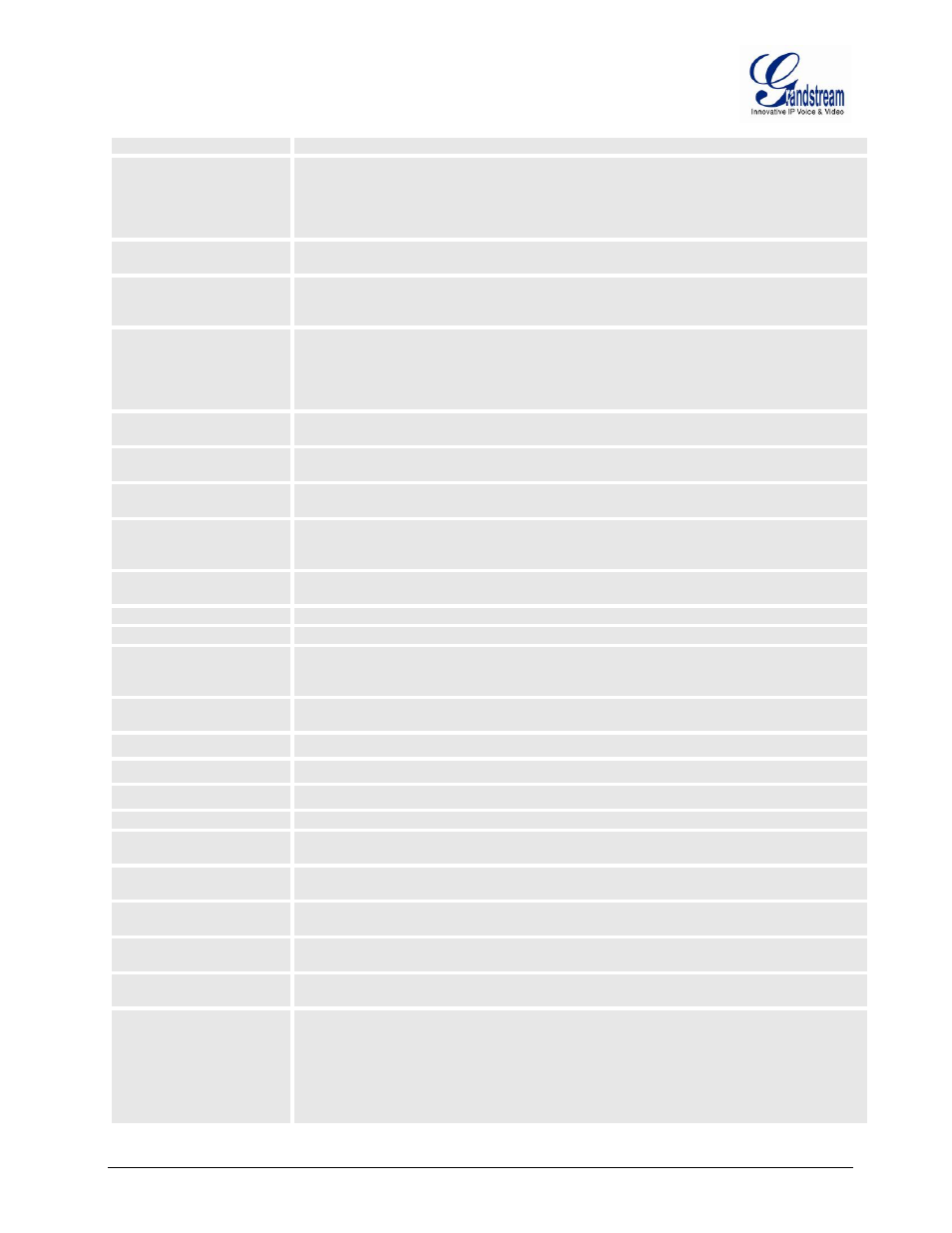Sip timer d, Sip register contact header uses, Caller id display – Grandstream DP715 User Manual User Manual
Page 48: Use privacy header, Use p-preferred-identity header, Do not escape '#' as %23 in sip uri, Disable multiple m line in sdpdisable multiple m, Authenticate incoming inviteupdate handset time

Firmware version 1.0.0.33
DP715/DP710 User Manual
Page 46 of 56
message
RFC rules. If message will not pass validation process, call will be rejected.
Check SIP User ID for
incoming INVITE
Default is No. Check the incoming SIP User ID in Request URI. If they don’t match, the
call will be rejected. If this option is enabled, the device will not be able to make direct IP
calls.
Authenticate incoming
INVITE
After enable, unit will chanllenge any incoming INVITE with the SIP account password.
Allow Incoming SIP
Messages
from SIP Proxy Only
Default is No. Check the incoming SIP messages. If they don’t come from the SIP proxy,
they will be rejected. If this option is enabled, the device will not be able to make direct IP
calls.
Caller ID Display
Default is Auto.
Caller ID will be found in order:
1) Use the caller id in P-Asserted Identity Header, if not found:
2) Use the caller id in Remote-Party-ID Header, if not found:
3) Use the caller id in "From" header.
Use Privacy Header
If set to Default, it will only add Privacy header when special feature is not Telkom SA or
CBCOM.
Use P-Preferred-Identity
Header
If set to Default, it will only add PPI header when special feature is not Telkom SA or
CBCOM.
SIP REGISTER Contact
Header Uses
Configure the SIP register contact header uses to LAN Address or WAN Address.
SIP T1 Timeout
T1 is an estimate of the round-trip time between the client and server transactions.
If the network latency is high, select larger value for more reliable usage. Default is 0.5
Sec.
SIP T2 Interval
Maximum retransmission interval for non-INVITE requests and INVITE responses. Default
is 4 Sec.
SIP Timer D
Set the SIP Timer D. Default is 0.
DTMF Payload Type
Sets the payload type for DTMF using RFC2833. Default is 101.
Preferred DTMF method
The DP715 supports up to 3 different DTMF methods including in-audio, via RTP
(RFC2833) and via Sip Info using SIP INFO messages. The user can configure DTMF
method in a priority list.
Disable DTMF
Negotiation
Default is No. If set to yes, use above DTMF order without negotiation
Send Hook Flash Event
Default is No. If set to yes, flash will be sent as DTMF event.
Enable Call Features
Default is Yes. (If Yes, call features using star codes will be supported locally)
Proxy-Require
SIP Extension to notify SIP server that the unit is behind the NAT/Firewall.
Use NAT IP
NAT IP address used in SIP/SDP message. Default is blank.
Use SIP User-Agent
Header
Used to replace the SIP User-Agent Header. Default is NO.
Do Not Escape '#' as
%23 in SIP URI
If set to “Yes”, device will use ‘#’ instead of %23 in the send URI.
Disable Multiple m line
in SDP
Default is No. If set to Yes, device will send only one m line in SDP, regardless how many
m field in the incoming SDP.
Ring Timeout
Default value is 60 Sec. Incoming call will stop ringing when not picked up given a specific
period of time.
Hunting Group Ring
Timeout
Default value is 20 Sec. If call is not answered within this designated time period, the
callwill be forwarded to the next member of a Hunt Group.
Hunting Group Type
Linear, parallel and Shared line.
Linear style will sort the call to the lowest-numbered available line; this is also
called “serial hunting”.
Parallel Style will ring all the handsets on incoming calls.
Shared line Style will ring all the handsets on incoming calls, any handset
member of the same hunt group that try to dial out while there is an ongoing call
it will be automatically conference in the ongoing call.
